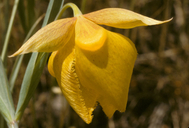Taxon Report
Calochortus pulchellus Benth.Mt. Diablo fairy-lantern |
 © 1981 Steve Lowens |
Taxon Summary
Calochortus pulchellus, commonly known as Mt. Diablo fairy-lantern, is a perennial bulbiferous herb in the Liliaceae that is found only in California. It occurs within Chaparral, Cismontane woodland, Riparian woodland, and Valley and foothill grassland, growing at elevations from 30 to 840 meters. Calochortus pulchellus is ranked 1B.2, Plants Rare, Threatened or Endangered in California and Elsewhere; Moderately threatened in California.Classification
|
Scientific Name: |
Calochortus pulchellus Benth. |
|
Common Name: |
Mt. Diablo fairy-lantern |
| Family: | Liliaceae |
| Element Code: | PMLIL0D160 |
| USDA Plants Symbol: | CAPU2 |
|
Synonyms/Other Names: |
|
Ecology and Life History
| Lifeform: | perennial bulbiferous herb |
| Blooming Period: Apr-Jun | Apr-Jun |
| Elevation: | 30-840 (100-2755) |
| General Habitats: | Chaparral, Cismontane woodland, Riparian woodland, Valley and foothill grassland |
| Microhabitat: | |
| Microhabitat Details: |
Conservation Status
| CA Rare Plant Rank: | 1B.2 |
| Global Rank: | G2 |
|
State Rank: |
S2 |
| State List: | None |
| Fed List: | None |
| Other Status: | SB_CalBG/RSABG |
|
CRPR Changes: |
|
Occurrence Data from the CNDDB
| Total Occurrences: | 52 |
| Element Occurrence Ranks: | |
| Excellent (A) | 2 |
| Good (B) | 17 |
| Fair (C) | 5 |
| Poor (D) | 2 |
| None (X) | 0 |
| Unknown (U) | 26 |
| California Endemic: True | |
| California Counties and Islands: Name (Code) | |
| Alameda (ALA), Contra Costa (CCA) | |
| Quads: Name (Quad Code) | |
| Antioch South (3712187), Benicia (3812212), Briones Valley (3712282), Byron Hot Springs (3712176), Clayton (3712188), Diablo (3712178), Las Trampas Ridge (3712271), Tassajara (3712177), Walnut Creek (3712281) | |
Threat List Data from the CNDDB
| Threat List Total: | 14 | |
| EOs with Threat Listed: | Total EOs | % of EOs |
| 21 | 40 % | |
| Road/trail construction/maint. | 10 | 19% |
| Foot traffic/trampling | 6 | 11% |
| Grazing | 6 | 11% |
| Non-native plant impacts | 4 | 7% |
| Erosion/runoff | 3 | 5% |
| Over-collecting/poaching | 3 | 5% |
| Recreational use (non-ORV) | 2 | 3% |
| Feral pigs | 2 | 3% |
| Other | 2 | 3% |
| Improper burning regime | 1 | 1% |
| Insufficient population/stand size | 1 | 1% |
| Vandalism/dumping/litter | 1 | 1% |
| Wood cutting or brush clearing | 1 | 1% |
| Development | 1 | 1% |
Notes
|
|
|
Threats: |
| Threatened by grazing, urbanization, horticultural collection, and feral pigs. Potentially threatened by road maintenance. |
|
Taxonomy: |
| See Proceedings of the California Academy of Sciences III 2:118 (1901) for taxonomic treatment, and Journal of Ecology 75:977-995 (1987) for population biology. |
Citation
California Native Plant Society, Rare Plant Program. 2025. Rare Plant Inventory (online edition, v9.5.1). Website https://www.rareplants.cnps.org [accessed 19 December 2025].